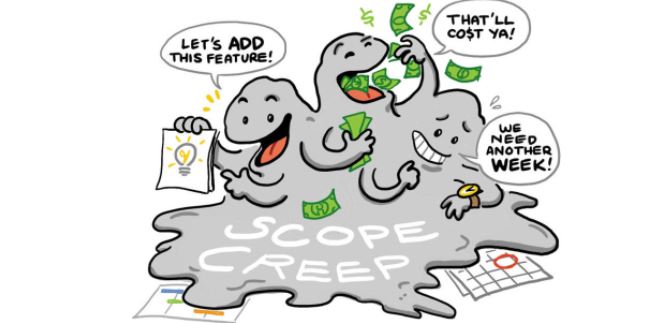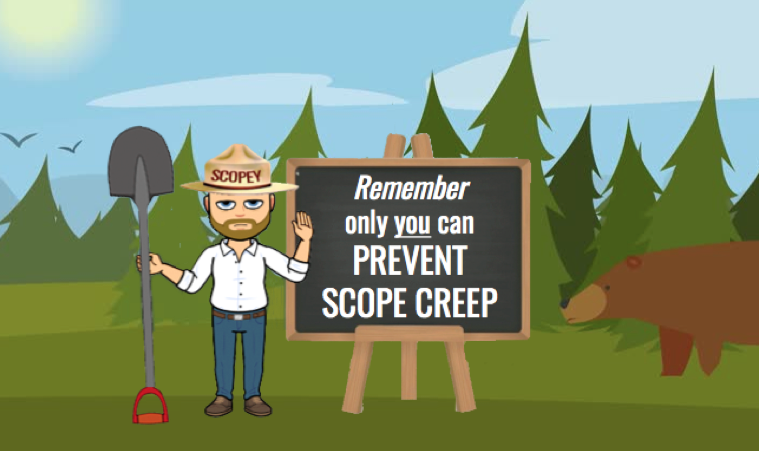
Scope creep can single-handedly kill your project profits and timeline. So, how can you kill scope creep before it kills you? Are you taking it seriously - you should?
There are dozens of ways to kill scope creep, but you need to fully understand what scope creep entails and how damaging it can be. The definition of scope creep is when a project’s scope changes, the project work starts to extend, or “creep”, beyond what was originally agreed. That is a simple definition but how does it truly effect you and your agency? In what areas is scope creep costing you more money and time? Just a few numbers for you:)
The above numbers are from a study by Villanova University to show that Scope Creep can effect you and your bottom line. The most effective way to get rid of scope creep is to simply Stop it before it starts. Taking preventative measures allows you to be proactive, not reactive.

How do you put yourself in a position where you can keep scope creep from happening? It is time to take a look at each one of your projects and see what changes need to be made to keep scope creep from destroying relationships and possibly tearing your agency a part.
Scope Creep - just like it's name - creeps up on you and before you know it you are losing money and clients. So many times we think it starts with project manager but in reality, it starts with the first contact, the "salesperson". Many times during the sales phase we may fluff things a little or not truly understand what the client needs. That is why it is vital to have a Client sign-off form.
Next is the Project Calibration Phase, the first step in the Perfect Project Management Lifecycle. This is when sales hands-off the project to the project manager and passes along everything they know about the client. This is also the first opportunity to prevent scope creep. The project manager needs to get a detailed report on everything sales said to the client. What is the client's budget, what's their role in the project, what are the expectations on completion time; basically, everything they expect you to do and when, etc.
This is very important to start the project off right and to keep in on track.
(RELATED: Learn more about Project Lifecycles and Eliminating Scope Creep our Online Project Management Course.)
A project scope document outlines the deliverables, constraints, and key success factors to ensure a common understanding among all parties. You must include the services and results that you will produce, the conditions that must be met for you to begin work, the time and costs associated with those services, and boundaries and exclusions for what you will not be doing or achieving. Coming to an agreement about all of these terms will ensure, in writing, that the client knows exactly what to expect. Doing this prevents them from coming to you halfway through the project and saying, “But I thought you were going to do ……”
Ultimately, if the project begins without a signed project scope document, the project manager is being set up for failure. Trust me, the time, resources, and deliverables will never stop changing. That’s just how clients with free reign act. Having the project scope document as proof of what was agreed upon will help the project stay within the original parameters.
Okay, so you’ve got your document and they’re ready to sign it. That means scope creep is dead right? Wrong.

Clients will always try to push the envelope. When you present the project scope document to the client you need to inform them that anything they want outside of the document will require a change order. This includes additional work, an earlier deadline, another revision or edit, or anything that changes the timeline or budget.
Change orders are a project manager’s best friend, they keep the team and the client inline and focused on the original goal. You don’t want to throw a change order at a client out of the blue though or you’ll seem like the bad guy. The goal is to have a client that’s a raving fan, and that’s going to be hard to do once you’ve made them mad. Informing them about the change order process upfront will prepare them. Let them know that the process in place to ensure that you’re able to deliver and meet their expectations.
If the client signs the project scope document and knows about the change order process before the project even begins they’ll be less inclined to ask for additional functionality, design elements, etc. Walking your client down this structured and predefined path also positions your agency as professional and prepared. Clients will ultimately appreciate this clarity and transparency because they’ll see how beneficial it is to having a successful project.

When it comes to scope creep it’s all about taking preventative measures. If you want to be known for world-class services you need to have the systems and process in place to ensure that every project runs smoothly, every single time!
Clients won’t be happy about change orders the first time they hear about them but when they get a stellar project delivered to them on time and on budget change orders won’t even cross their mind! Proper project calibration, a signed project scope document, and implementation of change orders will ensure that you’re stopping fires instead of putting them out.
(RELATED: Follow out Best Management Practices for Digital Projects to help the perfect the process..)
Kill scope creep! And as always reach out to me if you need a little help figuring out how to clean up your projects.

![[PODCAST] – Lee Jackson – Knowing The Value Of An Agency Coach How To Find The Right One For You](https://marketingagencycoach.com/wp-content/uploads/2020/08/Lee-Jackson-youtube-thumbnail-300x223.png)
![[PODCAST] Say Gabriel – 5 Point Content Framework for Agencies](https://marketingagencycoach.com/wp-content/uploads/2020/08/Screen-Shot-2020-06-29-at-9.57.15-AM-300x209.png)
![[PODCAST] – Ben Aston – Project management, and most importantly, profitability around your project manager.](https://marketingagencycoach.com/wp-content/uploads/2020/12/Troy-Howard-Thumbnail.-1-300x225.jpg)